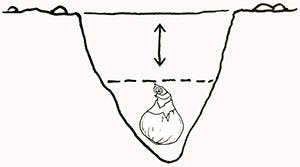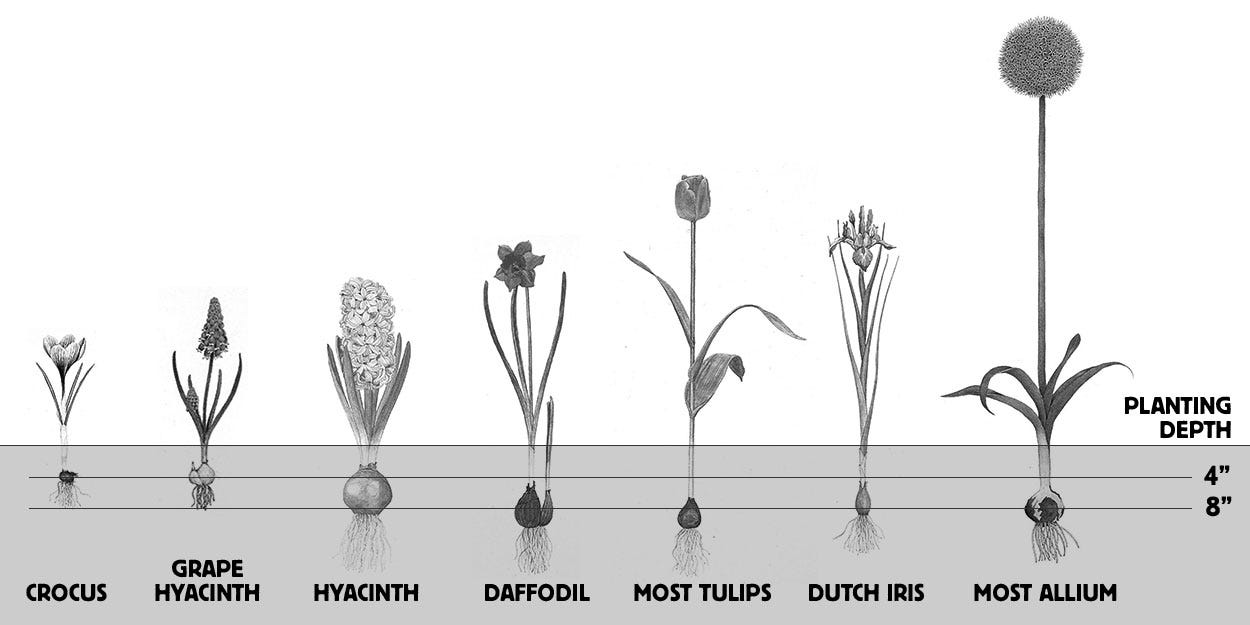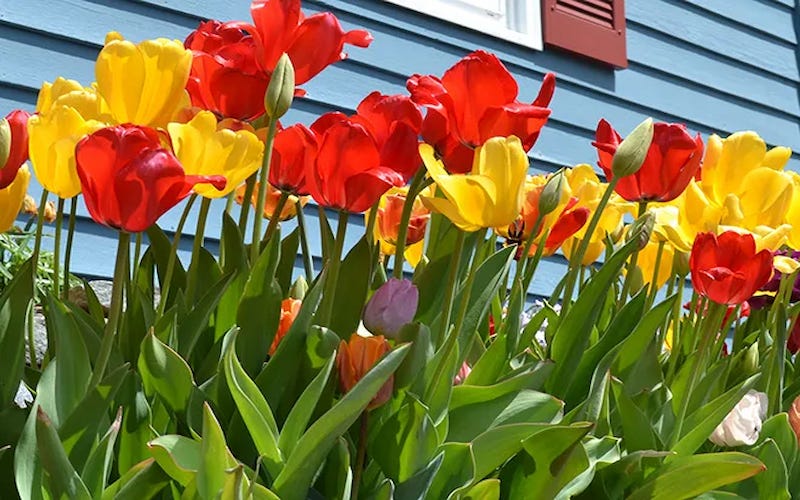
How To Plant Fall Flower Bulbs
Fall-Planted Flower Bulbs are loved by both beginner and master gardeners alike! These easy-to-grow bulbs include Tulips, Daffodils, Crocus, Hyacinths, Grape Hyacinths, and Snowdrops, which bloom in spring. These bulbs require periods of cold weather in order to bloom in spring. Plus, fall's cool temperatures make for an enjoyable gardening experience. Dig in!
Plan: When To Plant Fall Bulbs
Areas With Cold Winters (Zones 1-7)
In climates with cold winters, bulbs can be planted in the ground in fall, where they will chill long enough to develop spring blooms.
Fall bulbs should be planted as soon as the ground is cool, when evening temperatures are consistently between 40° - 50°F.
In fall, ground temperatures typically reach 40° - 50°F about 6-8 weeks before the ground freezes. That is the ideal planting window. However, as long as you can dig and your ground is workable, you can still plant!
You can, if necessary, store bulbs for a month or longer before planting, as long as you keep them in a cool, dry place.
Find Your Current Soil Temperature With This Interactive Map
Areas With Warm Winters (Zones 8-11)
In warmer climates, where winter temperatures are not cold enough to chill bulbs, you'll need to pre-chill your bulbs before planting.
To pre-chill, leave bulbs in their bags and place them in a refrigerator. Be careful not to store bulbs near fruit, (especially apples) because ripening fruit gives off ethylene gas, which can damage or kill the flower inside the bulb.
Once bulbs have chilled, plant them at the coolest time of the year in your climate.
Most importantly, bulbs won't last till next season, so make sure to plant them!
How long to chill bulbs?
Hyacinth: Chill for 11-14 weeks
Crocus, Grape Hyacinth, Scillia, and Tulips: Chill for 12-15 weeks
Daffodils and Specie Iris: Chill for 15 weeks
Plan: Where To Plant Fall Bulbs
Soil Moisture: You can plant bulbs just about anywhere in your garden, as long as the soil drains well. The Dutch say, "bulbs don't like wet feet." So, avoid areas where water collects, such as the bottom of hills.
Light Requirements: Bulbs like full sun. For bulbs that bloom in early to mid spring, the leaves on the trees will not be out yet, providing more sun.
Prepare Soil For Planting Fall Bulbs
For the best results, always prepare your planting bed before planting.
- Dig your soil so it's loose and workable. Remove any weeds, rocks or other debris.
- If it's not an established garden bed, chances are the soil could use the addition of some organic matter, such as compost, available at most local garden retailers. You can mix in compost, other organic matter or slow-releasing fertilizer if your soil lacks nutrients.
- Loosen soil in the planting bed to a depth of at least 8”.
Plant Fall Bulbs - Step By Step Instructions
Tips:
- When planting multiple bulb varieties, be sure to keep the label with your bulbs until planting. Otherwise you won't be able tell the red tulip bulbs from the white tulip bulbs just by looking at the bulbs!
- Plus, the label will give you a quick reference for how deep to plant each bulb.

- Dig your holes at the recommended depth for each bulb, as listed on the label. Dig the hole to a width that will fit the bulbs according to the spacing listed on the label (bulbs per square foot).
You can plant bulbs one at a time, but we typically recommend grouping bulbs for the best impact. - Set the bulb in the hole with the pointy side up and the roots down.
It's easy to spot the pointy end of a tulip, and tougher with a crocus. If you can't figure out the top from the bottom, plant the bulb on its side. In most cases, even if you don't get it right, the flower will still find its way topside. - Once the bulbs are in the ground, gently back-fill with soil to fill the hole. Lightly compress the soil, but do not pack it - you want to encourage roots to grow.
- Water once at planting time to fill any air pockets, and to stimulate root growth.
There is no need to water bulbs over the winter unless you live in an arid climate or an area with low precipitation in the winter months.
A Quick Look At Planting Depths For Fall Bulbs

Watch: How To Plant Tulips & Daffodils
Shop Fall-Planted Flower Bulbs
If no products are displaying, that means we do not have this seasonal product available for purchase at this time.
4 Planting Tips For Fall Bulbs
In the end, what you do with fall flower bulbs is limited only by your imagination!
- Plant flower bulbs in clusters. If you plant one flower bulb alone, or make a long thin line along the walk, the flowers may look sparse. For better impact, plant bulbs in clusters. This will create a concentration of color. Even in small spaces, the flower clusters will make a super spring show.
- Plant low-growing bulbs in front of taller bulbs. This is a good general rule for bulbs that bloom at the same time.
- Try a double-decker effect. You can plant small bulbs in a layer right on top of large bulbs. If you plant bulbs that flower in the same period you can create a dense, boldly colorful planting.
- Plant a mix of bulbs to extend your bloom time. Plant mid- and late-season bloomers together, creating a spring display that blooms in succession, for a whole season of color!
End Of Season Care For Bulbs In The Spring & Summer
Fertilizing: For bulbs that are intended to naturalize, or return for several years, or for bulbs that are coming into their second year, spread an organic fertilizer, such as compost or a slow-release bulb fertilizer, on top of the soil.
Pruning: When the flowers have completed blooming, cut the flower head off, but do not cut the foliage. Bulbs will use the foliage to produce and store nutrients for growth in the following seasons. Once the foliage has turned yellow or brown, you can cut them to ground level.


